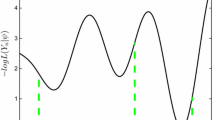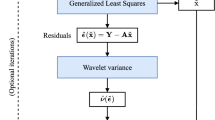Abstract
Identifying a periodic time-series model from environmental records, without imposing the positivity of the growth rate, does not necessarily respect the time order of the data observations. Consequently, subsequent observations, sampled in the environmental archive, can be inversed on the time axis, resulting in a non-physical signal model. In this paper an optimization technique with linear constraints on the signal model parameters is proposed that prevents time inversions. The activation conditions for this constrained optimization are based upon the physical constraint of the growth rate, namely, that it cannot take values smaller than zero. The actual constraints are defined for polynomials and first-order splines as basis functions for the nonlinear contribution in the distance-time relationship. The method is compared with an existing method that eliminates the time inversions, and its noise sensitivity is tested by means of Monte Carlo simulations. Finally, the usefulness of the method is demonstrated on the measurements of the vessel density, in a mangrove tree, Rhizophora mucronata, and the measurement of Mg/Ca ratios, in a bivalve, Mytilus trossulus.
Similar content being viewed by others
References
Beelaerts V, De Ridder F, Schmitz N, Bauwens M, Dehairs F, Schoukens J, Pintelon R (2009) On the elimination of bias averaging-errors in proxy records. Math Geosci 41(2):129–144
Beelaerts V, De Ridder F, Schmitz N, Bauwens M, Pintelon R (2010) Time-series reconstruction from natural archive data with the averaging effect taken into account. Math Geosci 42(6):705–722
Brüggeman W (1992) A minimal cost function method for optimizing the age-depth relation of deep-sea sediment cores. Paleoceanography 7(4):476–487
Butler P, Scourse J, Richardson C, Wanamaker A, Bryant C, Bennell J (2009) Continuous marine radiocarbon reservoir calibration and the 13C Suess effect in the Irisch Sea: results from the first multi-centennial shell-based marine master chronology. Earth Planet Sci Lett 279:230–241
Da Costa ED, Coloin de Verdiere A (2002) The 7.7-year North Atlantic oscillation. Q J R Meteorol Soc 128:797–817
de Brauwere A, De Ridder F, Pintelon R, Meersmans J, Schoukens J, Dehairs F (2008) Identification of a periodic time series from an environmental proxy record. Comput Geosci 34(12):1781–1790
De Ridder F, Pintelon R, Schoukens J, Gillikin DP, André L, Baeyens W, de Brauwere A, Dehairs F (2004) Decoding nonlinear growth rates in biogenic environmental archives. Geochem Geophys Geosyst. doi:10.1029/2004GC000771
De Ridder F, Pintelon R, Schoukens J, Gillikin DP (2005) Modified AIC and MDL model selection criteria for short data records. IEEE Trans Instrum Meas 54(1):144–150
Fishman R (1996) Monte Carlos: concepts, algorithms, and applications. Springer, Berlin
Fletcher R (1991) Practical methods of optimization, 2nd edn. Wiley, New York
Golub GH, Van Loan CF (1996) Matrix computations, 3rd edn. John Hopkins University Press, Baltimore
Gillikin DP, De Ridder F, Ulens H, Elskens M, Keppens E, Baeyens W, Dehairs F (2005) Assessing the reproducibility and reliability of estuarine bivalve shells (Saxidomus giganteus) for sea-surface temperature reconstruction: implications for paleoclimate studies. Palaeogeogr Palaeoclimatol Palaeoecol 228:70–85
Goodwin D, Prajbasaj P (2009) MoGroFunGen: A numerical model for reconstructing intra-annual growth rates of bivalve mollusks. Palaeogeogr Palaeoclimatol Palaeoecol 276:47–55
Goodwin D, Schöne B, Dettman D (2003) Resolution and fidelity of oxygen isotopes as paleotemperature proxies in bivalve mollusk shells: models and observations. Palaios 18(2):110–125
Herbert TD (1994) Reading orbital signals distorted by sedimentation: Models and examples, in orbital forcing and cyclic sequences. Spec Publ Int Assoc Sedimentol 19:483–507
Huang S, Pollack NH, Shen P (2000) Temperature trends over the past five centuries from reconstructed borehole temperatures. Nature 403:756–758
Hurrell JW (1995) Decadal trends in the North Atlantic oscillation: regional temperatures and precipitation. Science 269:676–679
Klein R, Lohmann K, Thayer C (1996) Bivalve skeletons record sea-surface temperature and δ 18O via Mg/Ca and 18O/16O ratios. Geology 24(5):415–418
Kuhnert H, Patzold J, Schnetger B, Wefer G (2002) Sea surface temperature variability in the 16th century at Bermuda inferred from coral records. Palaeogeogr Palaeoclimatol Palaeoecol 179:159–171
Lazareth CE, Willenz J, Navez P, Keppens E, Dehairs F, André L (2000) Sclerosponges as a new potential recorder of environmental changes: Lead in Ceratoporella nicholsoni. Geology 28:515–518
Lazareth CE, Vander Putten E, André L, Dehairs F (2003) High-resolution trace element profiles in shells of the mangrove bivalve Isognomon ephippium: A record of environmental spatio-temporal variations? Estuar Coast Shelf Sci 56:1–12
Lisiecki LE, Lisiecki P (2002) Application of dynamical programming to correlation of paleoclimate records. Paleoceanography. doi:10.1029/2001PA000733
Marshall JF, McCulloh MT (2002) An assessment of the Sr/Ca ratio in shallow water hermatypic corals as a proxy for sea surface temperature. Geochim Cosmochim Acta 60:3263–3280
Martinson DG, Menke W, Stoffa P (1982) An inverse approach to signal correlation. J Geophys Res 87(B6):4807–4818
Mucci A (1987) Influence of temperature on the composition of magnesian calcite overgrowths precipitated from seawater. Geochim Cosmochim Acta 51(7):1977–1984
Paillard D, Labreyrie L, Yiou P (1996) Macintosh program performs time-series analysis. Eos Trans AGU 77(39):379–379
Petit J, Jouzel J, Raynaud D, Barkov NI, Barnola JM, Basile I, Bender M, Chappellaz J, Davis M, Delaygue G, Delmotte M, Kotlyakov VM, Legrand M, Lipenkov VY, Lorius C, Pepin L, Ritz C, Saltzman E, Stievenard M (1999) Climate and atmospheric history of the past 420,000 years from the Vostok ice corse, Antarctica. Nature 399:429–436
Pintelon R, Schoukens J (2001) System identification: a frequency domain approach. IEEE Press, Piscataway
Ranner H, Ladriére O, Navez J, André L, Gillikin D, Keppens E, Dubois P the CALMARS group (2005) Do echinoderms store temperature changes in their skeleton? EGU Geophys Res Abstr 7:01098
Rolain Y, Pintelon R, Xu KQ, Vold H (1995) Best conditioned parametric identification of transfer function models in the frequency domain. IEEE Trans Autom Control AC-40(11):1954–1960
Schöne B, Freyre Castro A, Fiebig J, Houk S, Oschmann W, Kröncke I (2004) Sea surface water temperatures over the period 1884–1983 reconstructed from oxygen isotope ratios of a bivalve mollusk shell (Artica islandica, Southern North Sea). Palaeogeogr Palaeoclimatol Palaeoecol 212:215–232
Versteegh EAA, Troelstra SR, Dehairs F (2009) Is Greenland ice cap meltwater runoff recorded in growth increment chemistry of the bay mussel (Mytilus trossulus). Geol Soc Amer Abstr Progr 41(7):401
Vanheuzen A (1991) Analysis of solids by laser ablation inductively coupled plasma mass-spectrometer (LAICP-MS). 1. Matching with a glass mix. Spectrochim Acta Part B, At Spectrosc 46(14):1803–1817
Vanheuzen A, Morsink J (1991) Analysis of solids by laser ablation inductively coupled plasma massspectrometer (LA-ICP-MS). 2. Matching with a pressed pellet. Spectrochim Acta Part B, At Spectrosc 46(14):1819–1828
Weedon GP (1989) The detection and illustration of regular sedimentary cycles using Walsh power spectra and filtering, with examples from the Lias of Switzerland. J Geol Soc 146:133–144
Wei G, Li X, Sun M, Nie B (2000) Mg/Ca, Sr/Ca and U/Ca ratios of a porites coral from Sanya Bay, Hainan Island, South China Sea and their relationship to sea surface temperature. Palaeogeogr Palaeoclimatol Palaeoecol 162:59–74
Wilckinson BH, Ivany LC (2002) Paleoclimate inference from stable isotope profiles of accretionary biogenic hardparts—a quantitative approach to the evaluation of incomplete data. Palaeogeogr Paleoclimatol Palaeoecol 185:95–114
Yu Z, Ding Z (1998) An automatic orbital tuning method for paleoclimate records. Geophys Res Lett 25:4525–4528
Author information
Authors and Affiliations
Corresponding author
Rights and permissions
About this article
Cite this article
Beelaerts, V., Bauwens, M., Versteegh, E. et al. Periodic Time-Series Modeling of Environmental Proxy Records with Guaranteed Positive Growth Rate Estimation. Math Geosci 43, 635–662 (2011). https://doi.org/10.1007/s11004-011-9352-7
Received:
Accepted:
Published:
Issue Date:
DOI: https://doi.org/10.1007/s11004-011-9352-7




